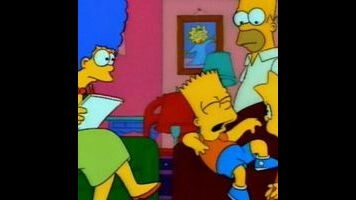In his beloved Hollywood memoir Adventures in the Screen Trade William Goldman criticizes his revered screenplay for Butch Cassidy and the Sundance Kid for being overly clever and cutesy. (One can only imagine what self-criticisms he might have made about his slightly less distinguished screenplay for Dreamcatcher.) Goldman singles out his classic comic western’s surplus of “reversals”—where audience expectations are subverted and upended in a clever fashion—as one of its chief faults.
Reversals are a potent tool. Like most potent tools, they’re best used in moderation. A handful of reversals can lend a screenplay or teleplay a thrilling element of surprise and throw audiences off balance. Indulge in too many reversals, however, and you risk losing the audience completely. Reversals work because they subvert expectations, but you can’t subvert non-existent expectations, and if a show or film gets too cutesy or convoluted, it’s liable to lose its human element.
“Bart the Murderer”, today’s episode of The Simpsons, straddles the fine line separating “clever” from “overly clever.” It helps that it never loses its human element and that, for the first act at least, we get to see Bart at his most vulnerable.
Like Butch Cassidy & The Sundance Kid, much of the episode's cleverness revolves around reversals. The entire plot hinges on one of the most inspired and unexpected reversals in the show’s history. In "Bart the Murderer," Bart becomes a precocious bartender/mascot/sidekick for Fat Tony and his legitimate businessman cronies. After Bart loudly complains to Fat Tony that Principal Skinner’s draconian rules are making his job prohibitively difficult, Tony and his thick-necked minions “have a little talk” with Principal Skinner, and in what appears not to be at all a coincidence, Bart’s nemesis then conveniently disappears.
We’re led to believe, of course, that Fat Tony and his boys took Principal Skinner for a little drive, followed by a permanent trip to the bottom of the ocean in a pair of custom-made concrete shoes. In a brilliant bit of misdirection, the show has Fat Tony’s genuine confrontation with Principal Skinner lead to nothing more than a bad mood on Skinner’s part that can only be alleviated through the soothing comforts of newspaper-bundling.
That's just one reversal in an episode full of them. Last week, Flanders failed. “Bart the Murderer” opens with Bart’s luck taking a turn for the tragic. A kid who generally has it all figured out suddenly can’t do anything right. Bart endures a gauntlet of misfortune and bad luck that sends him spinning unmistakably into Fat Tony’s axis.
On his very bad, no good, mixed-up day, Bart finds himself incongruously powerless. After ingratiating himself with Fat Tony due to his mixology skills, however, Bart suddenly has too much power. His wishes become Fat Tony and his men’s commands, and when Skinner goes missing, Bart develops a very guilty conscience expressed through one of the show’s many noir-stylized, Gothic dream sequences.
In another reversal, the harmless little boy is tried as an adult and betrayed by Fat Tony and his henchmen, who portray Don Bartholemew as the real brains behind the crime family. Joe Mantegna wasn’t the show’s first choice for the voice of Fat Tony (that’d be Sheldon Leonard), who was originally conceived as a one-shot character. But like so many of the show’s supporting characters, Fat Tony quickly became a pop-culture archetype. Mantegna nails the character’s exaggerated courtliness and faux-obliviousness; he’d be the very picture of meekness if he weren’t such a cold-blooded killer.
“Bart the Murderer” shifts tones and genres roughly every act. It begins as an episode about Bart losing his mojo, then morphs into a sly commentary on mob movies before becoming an absurdist legal drama where a little boy is depicted as a vicious murderer and vicious murderers portray themselves as doe-eyed naifs. Then in its final five minutes it morphs into something entirely different, a tongue-in-cheek boy’s own adventure story/MacGyver spoof chronicling Principal Skinner’s amusingly preposterous escape from his newspaper-prison.
Butch Cassidy & The Sundance Kid does arguably have too many reversals, but it’s still spectacularly entertaining. The same is true of “Bart the Murderer.” The central reversal of Principal Skinner being done in by newspapers rather than the mob isn’t clever for the sake of being clever: It’s also a genius gag.
“Bart the Murderer” marks the end of an era: The show went digital beginning with next week’s episode. “Bart the Murderer” is packed with incident without being overly busy and clever without being overly cutesy. By this point in its run, the series had attained a pleasing velocity and comic density. It was big, and it was fast, and it would only grow bigger and faster with time. Then came the slow decline, but we've got all the time in the world to deal with that.
Stray observations:
- I liked how the early, mild gag of Principal Skinner suggesting that Bart transform the mind-numbing busywork of licking envelopes into a game paid off neatly in the parallel gag of Skinner making a game out of how often he can bounce a basketball while imprisoned by vast oceans of newsprint.
- Does this episode mark the debut of Neil Patrick Harris’ self-mocking post-modern persona?

